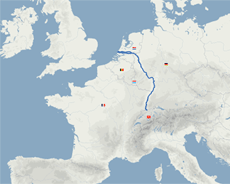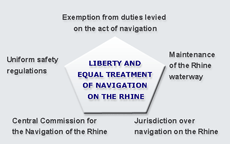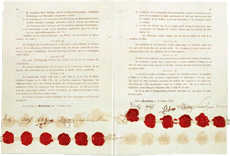Legal basis
Territorial scope
The Mannheim Convention is a complex agreement, and not all the stipulations it contains follow the same rules for application, more particularly with regard to their territorial scope of application. The following general indications do not take account of all the various application methods.

Upstream, the scope of application of the Mannheim Convention starts at the point where “natural navigation” begins (Appendix 16 B to the Vienna Final Document (Article 1)), which, according to the Swiss authorities, is located at the middle bridge upstream from the Port of Basle (the Mittlere Rheinbrücke, at km 166.64).
Downstream, the international scheme extends as far as the sea on all the waterways that lead from the Rhine to the sea or to Belgium (Article 2 of the Mannheim Document) that are used for commercial navigation. Between Krimpen and Gorinchem and the high seas, a number of specific rules apply.
The entire width of the river is subject to the international regulations; this includes the banks and towpaths, port waters and, to a certain extent, the quays and loading, unloading and storage areas (Articles 8 and 27 to 31 of the Mannheim Document).
The Rhine’s tributaries are partly subject to the provisions of the Convention, with regard to the freedom of navigation (Articles 3 and 4), subject to specific stipulations (such as the Convention of 27 October 1956 on the canalisation of the Moselle). The Main is considered a tributary as far as km 387.69 (Hallstadt railway bridge), except specific rules.

Material scope
The Convention contains a set of rules that are referred to collectively as “the Rhine scheme”; they cover various aspects of navigation.
Principle of the freedom of navigation

Navigation on the Rhine is open to all, subject to observance of the regulations which have been adopted for the purpose of maintaining general safety.
The scheme applies to commercial navigation. Specific rules apply to pleasure, sport and military vessels. Transport from one bank of the Rhine to the other is also excluded from the scheme (Article 24).
Navigation is open to vessels of any nation, although there are certain limits resulting from Additional Protocol No. 2 of 1982. The limitations concern vessels registered in a country that is neither a Contracting State of the Convention nor a Member State of the European Union. For these States, although transit traffic is free, “exchange” traffic is subject to agreements with the States concerned and cabotage traffic on the Rhine is subject to the conditions laid down by the Central Commission.
Cabotage traffic on the Rhine (i.e. traffic between two ports on the Rhine) is free and unrestricted for vessels entitled to registration in a CCNR or EU State. To benefit from this entitlement, there must be a real link between the vessel and the State concerned in accordance with the conditions laid down in the CCNR Application Regulation (Resolution 1984-I-3) and Community Regulation No. 2919/85 of 17 October 1985.
Principle of the unity of the scheme
In order to achieve freedom of navigation, the rules on traffic on the Rhine are contained in uniform regulations that are applicable on the entire length of the river (although this does not preclude specific provisions for certain sectors). These common regulations are decided on by the Central Commission.
To ensure the unity of the scheme, safety issues specific to navigation on the Rhine are settled by the CCNR alone. The States do not adopt provisions at a national level which would constitute a restriction on navigation on the Rhine unless they are general arrangements that are not specific to navigation, or the CCNR has specifically acknowledged the competence of the Member States (Article 23 of the Mannheim Document).
Principle of equal treatment
All the stakeholders in navigation on the Rhine must be treated equally, regardless of their nationality.
As a result, different treatment (for example, depending on the technical characteristics of the vessel) must be justified by objective elements in relation to general safety, orderly traffic, or the general interest (see decision adopted by the Chamber of Appeals 415 P – 1/03 on 10 February 2003 in the H case). ![]()
![]()

Principle of maintaining and improving the navigable waterway

The Mannheim Convention lays down the principle of the conservation, maintenance and improvement of the navigable waterway of the Rhine (see more particularly Articles 27 to 31).
Although the work this involves is carried out by the riparian States, the Central Commission monitors and operates concertation with regard to such measures – it examines work that might affect navigation, such as bridges, or alterations to the navigation channel.

Absence of rights specific to navigation
In application of Article 3 of the Mannheim Convention, the Member States must refrain from imposing any toll, tax, duty or charge based directly on the fact of navigation.
This rule has not prevented the prescription of a fee for services rendered or taxes on another basis, such as added value.
To supplement this arrangement, an additional agreement to the Mannheim Document was adopted on 16 May 1952 on the Customs and tax scheme for diesel oil consumed as fuel by vessels using the Rhine. Under this agreement, the CCNR Member States do not receive any Customs duty or other tax in respect of diesel oil consumed as fuel by vessels on the Rhine. ![]()
![]()
![]()
A number of the provisions of the Convention concern the Customs scheme, but are now less useful than they were previously.

Framework for regulating navigation on the Rhine
The Mannheim Convention combines freedom and order. The CCNR edicts regulations in order to ensure the safety of navigation on the Rhine. The regulations cover:
- technical prescriptions concerning vessels (Regulations on the inspection of vessels on the Rhine);
- rules on the people involved in inland navigation: Regulations on navigating personnel;
- rules governing traffic conditions (Police Regulations);
- rules governing the transport of dangerous substances (ADN Regulations).
The content of these regulations is set out in separate parts of the site.


